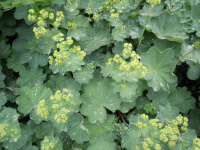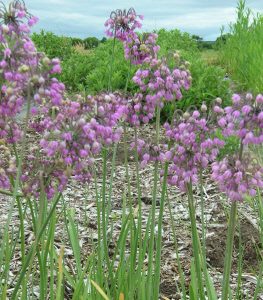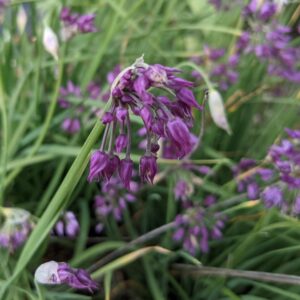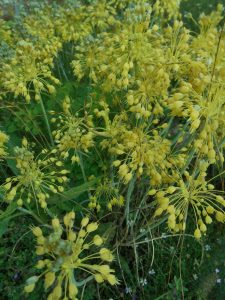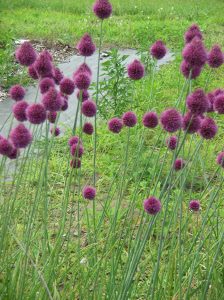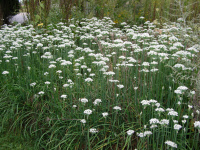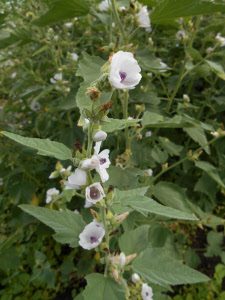Our Plants
Showing 25–32 of 616 results
-
Alchemilla mollis Lady’s mantle Z 3-8
June to July, clusters of starry chartreuse flowers bloom above sage green, scalloped, tooth-edged foliage that holds dew drops like beads of mercury.
June to July, clusters of starry chartreuse flowers bloom above sage green, scalloped, tooth-edged foliage that holds dew drops like beads of mercury.
Size: 12" x 12"
Care: Sun to part shade in moist soil
Native: East Carpathians, Caucasus
Awards: Royal Horticultural Society Award of Merit.Alchemilla derived from Arabic for alchemist, medieval chemists who attempted to transmute ordinary substances into gold. They used the dew drops which beaded on leaves to add to gold making recipes. “Lady’s mantle” comes from a legend that the plant was used to adorn the Virgin Mary. Gerard, a 16th century English herbalist, identified medicinal uses: cure inflammation from wounds, clot blood, help bruises and flu, aid conception and discourage miscarriages. Reputedly the plant also returned women to the former beauty of youth.
-
Allium cernuum Nodding onion, Prairie onion Z 4-8
Umbels of arching stems with nodding bells of lilac shading to pink
Umbels of arching stems with nodding bells of lilac shading to pink or occasionally white. May to June.
Size: 12”-18”x 3-6”
Care: sun to part shade in moist well-drained soil
Native: Canada to Mexico, Wisconsin native
Wildlife Value: nectar source for Hairstreak butterfly, Attracts hummingbirds.Cernuum is Latin meaning “nodding.” Many groups of 1st Americans ate the bulbs raw, roasted or dried for winter storage or as flavoring for soups and gravies. Cherokee used this plant medicinally to cure colds, hives, colic, “gravel & dropsy,” liver ailments, sore throats, “phthisic,” and feet in “nervous fever.” Those in the Isleta Pueblo were not quite as creative as the Cherokee and used this only for sore throats and infections. Meriwether Lewis collected this in Montana and wrote, “I met with great quantities of a small onion about the size of a musquit ball … They were crisp, white and well-flavoured. I gathered about a half a bushel of them before the crew arrivd.” Chicago is believed to be named for the Algonquin word for this plant chigagou.
-
Allium cyathophorum var. farreri Z 5-8
Clusters of nodding deep purple tubes flowering in late spring to early summer
Clusters of nodding deep purple tubes flowering in late spring to early summer
Size: 6-12” x 9-12"
Care: sun to part shade in moist to moist well-drained soil
Native: mountains of China.1st described in 1930.
-
Allium flavum var. minus Yellow flowered garlic
Umbels of shatter-shot yellow florets, like fireworks, bloom atop blue-green stems in July.
Umbels of shatter-shot yellow florets, like fireworks, bloom atop blue-green stems in July.
Size: 10” x 3”
Care: sun in moist well-drained soil
Native: Northern Turkey
Wildlife Value: resistant to rabbits & deer. Attracts bees and butterflies
Awards: species received Royal Horticultural Society Award of Garden MeritDescribed by Swiss botanist Pierre Edmond Boissier before 1885
-
Allium senescens Corkscrew allium, German garlic, Greater mountain garlic Z 4-9
Lavender balls, up to 30 of them, atop thin, bluish, strap-like, twisting foliage – mid-summer day’s dream.
Lavender balls, up to 30 of them, atop thin, bluish, strap-like, twisting foliage – mid-summer day’s dream.
Size: 6-12” x 6-12”
Care: sun to part shade in well-drained to moist well-drained soil
Native: Siberia
Wildlife Value: attracts butterflies & bees, deer & rabbit resistantCultivated before 1753. According to Philip Miller’s 1768 Dictionary, “planted in gardens for the variety of their flowers.”
-
Allium sphaerocephalon Drumstick allium Z 4-11
Claret colored, egg shaped flower heads
Claret colored, egg shaped flower heads top leafless stems in June to July. Good see-through plant to intermingle with purple coneflowers or tickseed. Good cut flower. Self-sows
Size: 2-3’ x 2-3”
Care: sun in well-drained to moist well-drained soil.
Native: Mediterranean, Caucasus & Europe
Wildlife Value: attracts bees, butterflies and other insects.In gardens before 1750. Used as an edging around vegetables at Mount Vernon.
-
Allium tuberosum Garlic chives
August & September bright white balls the size of golf balls on erect stems. Pretty in fall gardens.
August & September bright white balls the size of golf balls on erect stems. Pretty in fall gardens.
Size: 12-18” x 8”
Care: Full sun or shade in any soil
Native: SW Shanxi China
Wildlife Value: nectar source for many butterlies including the Tiger Swallowtail.Used medicinally in Asia as a remedy for incontinence, bladder weakness, kidney trouble and knee injuries. Traditional Chinese medicine practitioners made a powder from the seeds called Jiu Cai Zi used for numerous ailments. Widely grown as a vegetable.
-
Althaea officinalis Marshmallow Z 4-9
Small pale pink mallow-like blooms climb tall spires from July to September
Small pale pink mallow-like blooms climb tall spires from July to September
Size: 5-6’ x 3’
Care: Full sun moist to moist well-drained fertile soil. Heat and drought tolerant, stands up to wind.
Native: Central, south and east EuropeAlthaea is Greek meaning “to cure.” This was identified by Dioscorides in De Materica Medica for medicinal use around 70 A.D. More than 2000 years ago ancient Egyptians added honey to the cooked root. Ancient Romans used leaves and flowers as a strewing herb to repel lice and fleas. Emperor Charlemagne (742-814) cultivated the marshmallow in his gardens. According to Nicholas Culpepper, 16th century English herbalist, marshmallows were a medicinal candy. The plant eased pain, helped bloody fluxes, the stone and gravel and gripping of the belly. The marshmallow was considered to be an herb of Venus meaning that it voided offensive humors, made milk for nursing, cured bee stings, dandruff, balding and coughs. The French concocted the fluffy white confection in the mid 1800’s “from a decoction of marshmallow root, with gum to bind the ingredients together, beaten egg white to give lightness and to act as a drying agent, while sugar was incorporated to make the whole palatable.” American gardens since 1700’s when John Bartram (1699-1777) received seeds from Europe. Jefferson grew it at Monticello. Grown at America’s 1st botanic garden, Elgin Botanic Garden 1811.

